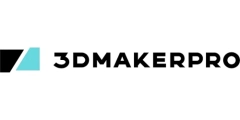- All
- Deals
- Coupons
- Sales
- Expired
Here’s a detailed breakdown of the 3DMakerPro brand — what they make, how they’re viewed, and what to watch out for (especially if you’re in a region where import and support may matter).
✅ What 3DMakerPro Is
-
3DMakerPro is a company based in Shenzhen, China (founded around 2015) that specializes in 3D scanning hardware — handheld and desktop scanners rather than (primarily) 3D printers.
-
They have a product range including models like the Mole, Seal, Lynx — each targeted at different segments of the 3D-scanning market (hobbyists, professionals) with accuracy claims in the sub-0.1mm range.
-
Example: The Mole 3D Scanner is reviewed as offering “up to 0.05 mm accuracy” and a 10 fps scan rate.
-
Their software (called JMStudio) is integrated with their scanners, offering capture + editing + mesh export (OBJ/STL/PLY) workflows.
🎯 What They Offer / Key Features
-
High-precision scanning: Their claim of 0.05 mm (50 micron) accuracy for models like Mole is impressive for non-industrial scanners.
-
Marker-free workflow: The “Mole” especially uses visual tracking (no physical markers needed) which simplifies setup.
-
Portfolio variety: They cover entry models (Seal), mid (Mole) and larger object scanning (Lynx) with different workflows (handheld, turntable) and accessories.
-
Export flexibility: Models can be exported in standard formats for printing or further processing (important if you are doing 3D printing, reverse engineering, scanning for CAD).
✅ Strengths & What Users Like
-
Reviewers found that the hardware is well built for the price point. For example, CreativeBloq said the Mole “performed incredibly well … well designed … ideal for a wide array of situations.”
-
For many hobbyists / makers the value proposition is strong: high precision at relatively lower cost vs industrial scanners.
-
The marker-free scanning and ease of handling (especially for smaller objects) are cited as convenient features.
⚠️ Weaknesses / What to Watch Out For
-
Even though the claimed accuracy is high (0.05 mm), some real-world users report that fine detail (especially for very small or dark objects) is not always captured perfectly. For example, one user said:
“It required chalk spray for dark objects, the software doesn’t track or align worth a damn…”
So the ideal conditions / object types matter a lot. -
The software (JMStudio) has been pointed out as having some issues: crashes, manual cleanup needed, especially when processing large scans.
-
Support / ecosystem outside major markets may be limited: accessories, calibration, service may be harder to source depending on region.
-
Because shipping a scanning device, software licensing, and calibration matter, import cost + local support may add up if you’re outside China / major markets.
🧭 Is It a Good Fit for You?
Good Fit If You:
-
Are a maker, hobbyist, designer, or small business in US doing 3D printing, modelling, reverse engineering, art/design who needs a good‐quality scanner.
-
Are comfortable with technical setup: scanning workflow, software, calibration, post-processing.
-
Are willing to import equipment, manage shipping/customs, and maybe source accessories locally or via international order.
Maybe Less Ideal If You:
-
Need a plug-and-play solution with robust local service/parts support in Pakistan.
-
Are scanning very large objects (the model may target medium sized items) or extremely fine details requiring industrial scanner performance.
-
Are worried about returns, warranty, calibration service — those can be trickier when imported.
📋 Key Things to Check Before Buying
-
Scanning target size & object type: Make sure the scanner’s specifications (working distance, capture volume) match the objects you plan to scan (small parts, large objects).
-
Surface/material compatibility: Dark, shiny, transparent surfaces are more challenging to scan. You may need to use spray or pre-treatment. Some users noted difficulty with dark objects.
-
Software & workflow: Confirm the software license, compatibility (Windows/Mac), export formats, whether you need third-party tools for cleanup.
-
Calibration & accessories: Does the kit include turntable, tripod, handles? Are calibration plates included? Some packages (“premium combo”, “luxury combo”) add accessories.
-
Support / parts / warranty: Check whether in Pakistan or near region there is support, spare parts, how shipping for repairs is handled.
-
Total landed cost: Product price + shipping + taxes/duty + import clearance + possible extra for accessories/local adapter/invoice.
-
Documentation & reviews from similar region: Try to find users in South Asia or nearby who have imported it — this helps gauge how feasible setup/support is locally.
-
Use case clarity: Make sure scanning need justifies the cost; if you only need very simple scans maybe a lower‐cost/scanner may suffice.
🔍 My Verdict
3DMakerPro is a legitimate and strong option for 3D scanning hardware in the maker / semi-professional space. They offer good features at competitive cost. However the typical caveats apply: the highest performance claims may be under ideal conditions, the workflow requires attention, and importing to Pakistan will involve extra logistical considerations.
If you’re keen and ready to work a bit (setup, calibration, software cleanup) and understand the extra import cost & support angle — it’s quite a good buy. If you prefer a fully supported local solution with minimal hassle, you might also consider alternatives that have better regional support.

